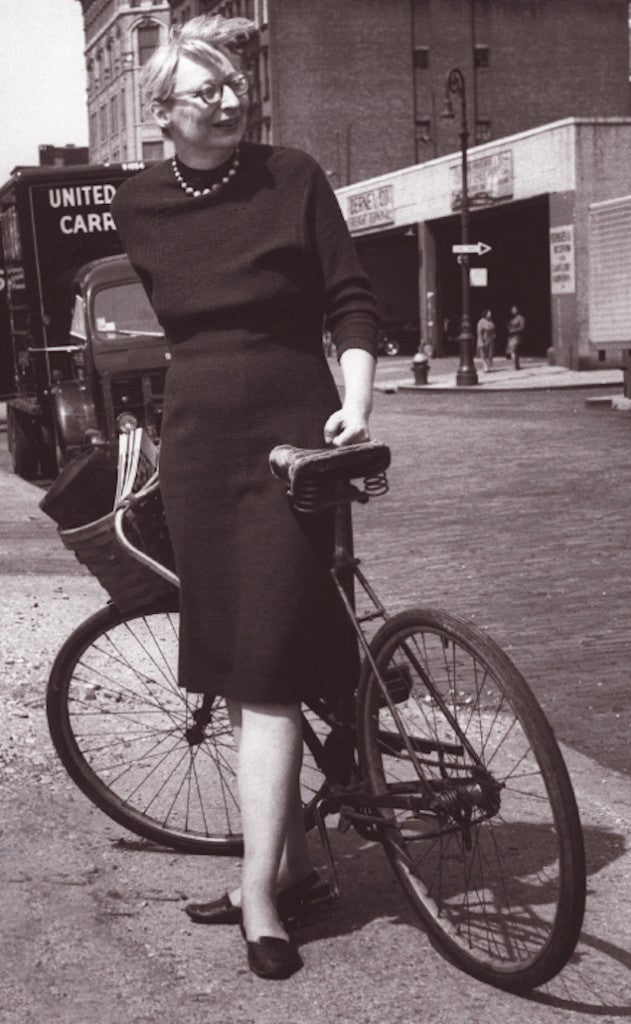
JANE JACOBS
Remember Woody Allen’s description of growing up in a house under a roller coaster in the Coney Island section of Brooklyn? Now add a torture scene from The Battle of Algiers to that scenario, a sanitation truck on your doorstep grinding garbage at 3 a.m., jackhammering at 7 a.m., and the sound of massive iron plates being run over by traffic en route to the Holland Tunnel, and you begin to get the flavor of life today in the posh West Village of Manhattan. So a flurry of books, films and an opera about cities and the life of writer/activist Jane Jacobs---who championed the West Village of the 1950s and 60s---has me thinking further about the tipping point in the life and death of a city. About just how much development a culture can endure before phase transition is inevitable, i.e., before the culture vanishes, and what initiatives might prevent its demise.
The West Village (population 34,000) has long been one of the most creative and historic parts of New York, its 19th and early 20th century residential townhouses, carriage houses and worker row houses protected city landmarks. Fifty blocks constitute the historic district. Of “outstanding universal value” are the streets particularly in and around Bedford, Barrow, Morton and Cherry Lane, which need further protection if they are to remain habitable. Indeed, they deserve World Heritage Site status.
Instead, the West Village is plagued by mini-earthquakes from a subway system way too fast for the buildings above it. Its narrow streets are being ripped to shreds daily (for the next two years, I’m advised) to replace apparently aging water, gas and electric lines as well as to lay-in fiber optics. But will the patient survive the fracturing and gouging of streets; the Bobcats and Caterpillars careening unannounced through roads designed for travel by horse and buggy; the half-a-block-long trailer trucks and freezer truck deliveries; and the deafening municipal sirens that can be heard half-way across the Hudson River?
(Full disclosure here. I have called the West Village home since the early 1970s.)
If the MTA (Metropolitan Transit Authority) can get the seismic issues under control, I do actually like the idea of a “SubEx,” an underground delivery system that makes it possible for behemoth trucks not to have to enter the city to unload. The now operational Amazon-goes-subway courier system for delivery to Amazon’s Prime customers is one small step in that direction.
But there are other problems facing this part of town. The West Village is already a museum of sorts. On any given day, tour groups clamor to see exactly where television episodes of Friends and Sex and the City were shot; to discuss the Commie era and Prohibition in front of Chumley’s speakeasy (where cocktails are now $17); and to have a look at the sign affixed to the one-time residence of poet Edna St. Vincent Millay---the narrowest house in New York---bearing her famous words: “My candle burns at both ends.” Poet and Nobel Laureate Joseph Brodsky’s former home on Morton Street has so far been spared it seems.
Outdoor cafes, licensed by the city, now extend virtually to the curb where tourists join the New York University crowd in drunken merriment. Meanwhile, normally entrenched film crews---also city-licensed and with police protection---have for the moment retreated because the streets are too chaotic to roll camera.
As in every other corner of New York surveillance in the West Village is pervasive, but useless here in dealing with messy parade crowds the neighborhood can no longer absorb. Long overdue is a relocation of such international spectacles to Fifth Avenue, but officials lack even the political will to tackle a project as simple as that.
Decades ago in a victory by Jane Jacobs over developer Robert Moses, as the excellent documentary Citizen Jane highlights, a plan to extend Fifth Avenue through Washington Square Park was stopped. Former New York Mayor Ed Koch said the plan was to call the thoroughfare: “Fifth Avenue South.”
So why is the West Village now being sacrificed to commercial interests? There will soon be nothing left for tourists and film crews to pan but a museum. The West Village will be lost to the ages---a Çatalhöyük. Living here will be intolerable.
The other phenomenon killing the West Village is New York University’s real estate encroachment to accommodate its ever-expanding campus and ever-expanding student enrollment. As the neighborhood changes, upscale restaurants can no longer make ends meet and are forced to move, giving way to pizza, burger and beer halls.
The university’s commercial greed is further exposed in the film The Lost Village---shown recently to a standing-room-only audience at Jefferson Square Market Library. It includes testimonies by a growing number of neighborhood Mom & Pops who can’t pay the rent, and NYU students financing their expensive educations through prostitution.
The Citizen Jane film documents the efforts of Jane Jacobs to save the West Village from outrageous development in the 50s and 60s and opens with the unmistakable voice of Santa Fe Institute physicist Geoffrey West and these profound words “Cities are in many ways the greatest invention that human beings have brought to the world.”
West does know cities. He grew up “streetwise” in the East End of London in the 1950s before brilliantly finding his way to Cambridge University. And now travels extensively giving talks. He says he still prefers the life of a gentleman scholar although decades ago chose to settle in Santa Fe (population 70,000)---America’s oldest capital city, now famously the home of the Santa Fe Institute---where he is Distinguished Professor and Past President.
West and Jacobs, both of course, put the emphasis on humans in their respective views of cities, but Jacobs much more so. She saw the street as a “ballet.”
West says Jacobs saw the street as the city’s “soul.” West has also said: “Here in Santa Fe you’re on your own, that’s what the landscape says: You will have to confront God.”
One wonders if West’s John Templeton Foundation funders haven’t had a bit of influence on him after all.
As a physicist West is especially concerned with the “exponential expanding fashion” of cities, the intensity, the speeding up and ramping up of cities as population size increases, and how crucial it is to get the planning right. Some of this he touches on with me in a two-part conversation, and in a hundred pages or so in his recent book Scale. Curiously, I see no reference to Templeton anywhere in the book, no acknowledgment of the $2.5M grant to him for research on Complexity. West’s savvy agent, John Brockman, may have cautioned against it.
One of the more fascinating descriptions in Scale is West’s look back at his years growing up in London’s East End as a teen and his summer jobs loading crates of beer on the dock for 9 ½ hours a day, five ½ days a week at 15 cents an hour. That and his California university days in the 60s and later overseeing the high energy physics department at Los Alamos are the backdrop for a novel it seems. Why not? West is a terrific storyteller.
Another recent book that gives some consideration to cities is Duke University engineer Adrian Bejan’s The Physics of Life. Bejan looks at the “vascularization” of cities, how dirt paths between houses morphed into streets, avenues, overpasses and subways. Bejan says early cities were organized along more natural lines, lanes to the market and other meeting points, off-the-grid in contrast to the grid-like patterns of today’s cities. It’s a theme that gets some play in Citizen Jane as well.
Coincidentally, Jane Jacobs grew up a couple of miles from where I did in NEPA (Northeastern Pennsylvania), although decades earlier than me. NEPA was also a crucible for Frank Carlucci III, Joe Biden, Joe Pisarcik, and Russell Bufalino et al.
Jane Jacobs later lived at 555 Hudson Street in the West Village, directly across the street from my boyfriend’s place in the 1970s. However Jacobs had moved to Toronto by then, and I never did get to meet her for a chat on the stoop.
